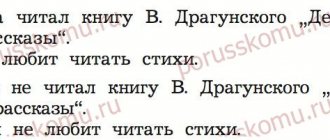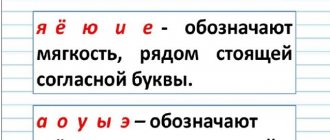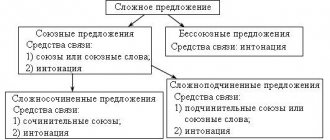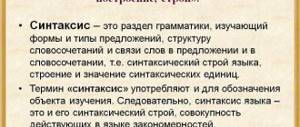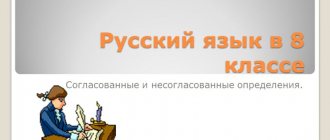What is text?
A text in Russian is several sentences united by one topic. The sentences in the text are connected in meaning. It has a theme, main idea and semantic completeness. Consists of several parts: introduction, main part and conclusion. Each piece of text begins with a red line. ()
Types of text are distinguished based on content:
- narration;
- description;
- reasoning.
Narration – shows action happening gradually, with consistency. Actions are connected to each other. The narration is conducted from the first and third person. This type has a beginning, development of action and denouement. The predominant part of speech in the text is the verb. The questions asked about the text are “what?”, “where?”, “when?”, “what happened?”, “where and with whom did it happen?”
Today is Saturday! This means that you don’t have to go to school, you can relax. Mom, Dad, and I will go to the zoo to look at different animals: elephants, giraffes, hippos, lions. Then we’ll go to the children’s cafe to eat ice cream and drink lemonade. When we return home we will watch cartoons together.
In this text it is clear that actions occur sequentially. ()
Description - describes, characterizes an event, an object, reveals the main features. The description can be portrait or landscape. A person, a plant, an animal, emotions (joy, sadness), weather conditions can be described. Parts of speech are often used in the text - adjective, noun, adverb. The description answers the questions “which?”, “which?”, “which?”.
Autumn! Bright colorful time of year. The trees stand in beautiful robes. Yellow, red, green leaves delight our eyes. The sun is shining, but its rays are becoming less warm and gentle.
The text describes and characterizes autumn as a colorful season. ()
What is a discourse text? The argument expresses the personal opinion of the author and explains the phenomena. An argumentative text sets the task of proving, convincing, or explaining something. The following words are typical for reasoning: firstly, if, then, therefore.
Reasoning is divided into types:
- reasoning-proof (why exactly?)
- reasoning-explanation (what is it?)
- reasoning-reflection (what to do?)
I got a D in math. What happens if I tell my parents? They will scold you and will not allow you to play with toys, eat candy or watch TV. What if I remain silent and don’t talk about the sinister two? I think they will find out anyway; secrets always become clear. They will be offended by me for lying to them. It's better to tell the truth.
()
Working with text in Russian language lessons in 4th grade
Dubinina Natalya Nikolaevna
Working with text in Russian language lessons in 4th grade
Working with text in Russian lessons.
(from work . Teacher: Dubinina N. N.)
(Textbook of the Russian language for grade 4 , educational complex “Primary school of the 21st century”
)
Working with text in primary school is a requirement of the time.
Russian language textbooks “Primary School of the 21st Century”
includes blocks:
1. How our language (linguistic knowledge is given)
2. Spelling (literate writing skills are developed)
3. Development of speech ( work on the text , its structure, types of texts )
I believe that speech development lessons the Russian language . These lessons cannot be thrown away , cannot be replaced, cannot be canceled, because from year to year they raise the child to a higher level of development. grades 4 all-Russian tests are carried out , and in grade 11, when passing the Unified State Exam , part c is working with text . And if we, primary school , develop skills in working with text , it will be much easier for children in middle school .
We begin work grade . In the first grade , when teaching literacy, concepts such as: word, sentence, text .
In second grade , we introduce children to types of text : description, narration, reasoning. I work frontally , with the whole class . The texts in the textbook are given ready-made.
In third grade we learn to create our own texts , we begin to learn how to write expositions, we learn to write essays, we learn to write letters. The result “Speech Development” block
is a comprehensive
work with text , which I usually carry out over half a year. This does not include: drawing up a plan for the text , coming up with a title for the text , restoring paragraphs, supplementing the text .
In the fourth grade, on the block “Speech Development”
29 hours are allotted.
Work continues on improving speech skills, on the correctness, accuracy, and expressiveness of written speech.
Immediately at the first lesson , children write a letter to the authors of the Russian language . The work is done frontally: discussed with the children, we choose the best.
There are a lot of texts in 4th grade textbooks . They are on a wide variety of topics. Interesting questions and tasks are given for each text Somewhere you need to retell the story of what is happening, using the source text , somewhere you need to title the text , draw up an outline for the text , come up with an ending. There are tasks where children determine the type of text .
In the 4th grade, text assignments with a greater degree of independence , restore the correct sequence of paragraphs, and draw up a plan independently.
What should you pay attention to when working with text ?
1. Why this passage can be called text . (Children must clearly know what is called text )
2. Understanding the text . (What is the text , what is its topic)
3. Divide the text into paragraphs . (Know what a paragraph is)
4. An important question is: did you like the text ? (Starting from this question, we come to the position of the author, that is, to the main thoughts of the text . What does the author teach? Does he convince? Does he affirm?
There are many creative tasks in the Russian language Children must come up with the texts . Such works must be checked by me. We discuss it with the guys in class We choose the best ones and read them out loud. You cannot ignore errors associated with violation of correct speech. I try to correct any noted defect. I immediately warn you about speech and grammatical errors. The texts in the textbook are very good; they expand the language horizons of students .
The daily, painstaking, high-quality work of a primary school teacher on texts gives good results.
At the end of 4th grade, my students are able to :
1. Answer questions about the text .
2. Divide the text into semantic parts and make a plan.
3. Highlight the main idea of the text , title the text , determine the content of the text .
4. Correct deformed text .
5. Find linguistic means that make the text expressive and find errors that violate the logic, correctness and accuracy of the text .
6. Write educational statements.
Semantic and grammatical connection of sentences in the text
The sentences in the text are connected in meaning. The semantic connection of sentences in the text is important; if the text included completely different sentences, it would be incomprehensible and difficult to understand.
Types of semantic connections between sentences in the text:
- Chain link
- Parallel communication
Chain connection - a new sentence complements the previous one. The author expresses thoughts consistently. Information from the first sentence is developed in the second, from the second in the third.
Don’t offend the book, my young comrade! She is a friend and ally for life. In it you will find answers to your questions.
Parallel connection - sentences do not depend on each other, but are united by a common statement.
Morning has come. The city wakes up, the sun rises high, high. You can hear the voices of people and the singing of birds.
The first sentence is the general theme for the subsequent sentences.
In addition to the semantic connection, there is a grammatical connection in sentences. It means that the forms of words depend on each other. Words in sentences of the text must agree; pronouns, prepositions, and conjunctions help with this.
I'm looking forward to when we put up the Christmas tree. She will be lush, beautiful and elegant.
Without the semantic and grammatical connection of sentences, a text cannot exist; it cannot be created.
Russian language lesson “Text and its plan”, 4th grade. School of Russia
Russian language lesson notes, 4th grade.
Topic: “Text and its plan.” Author: Bodenova Valeria Sergeevna, 3rd year student in specialty 02/44/02 Teaching in primary classes of advanced training. Description: This material will help primary school teachers. It is intended for children in 4th grade. Teachers can conduct a Russian language lesson on this topic. Objectives: to clarify ideas about the features of the text as a unit of speech; develop the ability to write a text outline. Formed UUD: cognitive - independent identification and formulation of a cognitive goal; conscious and voluntary construction of a speech utterance in oral and written form; building a logical chain of reasoning; proof; communicative - mastery of monologue and dialogic forms of speech in accordance with the grammatical and syntactic norms of the native language; regulatory - setting an educational task; comparison of the method of action and its result with a given standard; assessing the quality of the level of assessment of the material; personal - moral and ethical assessment of the acquired content, ensuring personal moral choice based on social and personal values. Equipment: Lesson developments in the Russian language for teaching materials of V.P.
Kanakina, V.G. Goretsky (“Russian School”), 4th grade / Authors - T.N. Sitnikova, I.F. Yatsenko. Progress lesson
1. Organizational moment. - Hello. - Be diligent in class. Be calm and attentive. Write everything without falling behind, Listen without interrupting. Speak clearly, clearly, so that everything is clear. If a friend begins to answer, do not rush to interrupt. 2. Updating knowledge. - Let's check your homework. (Children tell messages about polite words.) - Do you think it is necessary to be polite and why? - Read it. E. Shim-Birch.
We birch trees are good mistresses. We decorate the earth. Wherever you go, you will meet us everywhere. And in the dense forest there are birch trees. And in a swamp, among hummocks and mosses. Silky foliage rustles and whispers, birds build nests on the branches, light spills over the ground from the white trunks. — Can these sentences be called text? (Yes.) - Prove that this is a text. -What does the text say? - Find the spelling in the word birch and highlight it. — What tasks will we set for today’s lesson?
3. Studying new material.
Work according to the textbook.
Exercise 5 page 8. - Read these sentences.
— Can these sentences be text and why? (This is a text because the sentences are related to each other in meaning.) - What connection do sentences 2 and 3 have between each other? (The pronoun she indicates that we are talking about a birch.) - What epithet did the author use when describing a birch. (Green beauty.) - What does the text say? — How would you title the text? — Complete the tasks for the exercise. (Self-test and self-assessment.) Exercise 6 page 8.
- Read the poem.
— What feelings did you experience when you read the poem? - Read the poem expressively and try to convey the author’s feelings in your voice. -What does the poem say? (About the homeland.) - What is the main idea of the poem? (Children's answers.) - Write down this poem, following the rules when writing poetry. 4. Physical exercise. Our fingers worked and wrote well. They tried so hard, but now they are tired. We will rest a little and clench our fists with strength. We unclench our fingers and squeeze them again. One, two, three, four, five - You can wave them. We lower our hands into a clean stream, And we remove fatigue from our fingers with water (Children imitate washing their hands; the following words are pronounced as they exhale.) Thank you, water, for new strength. Now we will write all the letters beautifully. 5. Consolidation of what has been learned . Exercise 7 page 9.
- Read the text.
— What is the difference between the topic and the main idea of the text? The title of the text tells us what? — How can a text be divided into parts? — What parts of the text do you know? How are they different from each other? — What does the outline of the text consist of and what should it include? — Try to make an outline of this text. (Children work in pairs, and then one of the students voices his plan, and at the end the teacher and the students analyze and write a general plan on the board.) - Try to retell the text according to this plan. — Did the plan help you and how? Do you think it is necessary to draw up a text plan? 6. Reflection. — What does the text consist of? — How does the text differ from ordinary sentences? — What was the most interesting thing in the lesson? - Write down your homework, read page 9. - Thank you for your work.
We recommend watching:
Spelling dictation in 4th grade Synopsis of a Russian language lesson in 4th grade Synopsis of a Russian language lesson in 4th grade “Spelling of unstressed case endings of names exist Synopsis of a Russian language lesson in 4th grade
Similar articles:
Russian language lesson notes, grade 4. Homogeneous minor members of the sentence
Test work in the Russian language on the topic “Pronoun” in 4th grade
Test work in the Russian language on the topic “Homogeneous members of a sentence” in grade 4
Summary of a literary reading lesson in 4th grade on the topic: Satire and humor. Nikolay Nosov “Fedina’s task”
Final test work on the topic “Syntax”, 4th grade
What is a text title
Let's look at what a text title is. The title of a text in Russian is one of the main components of the text. The title of the text reflects the topic, the main idea. Helps to guess what the text is about and to understand the meaning of the text.
Ball
I dreamed of a soccer ball. The boys from the yard had balls, but I didn’t. They, of course, let us play, but as the evening wore on, the hosts took the balls home. Mom promised that if I study well, she will fulfill my dream. I studied well, brought home A's and helped my mother around the house. And then the day came when mom brought home the ball. He was beautiful, big and, most importantly, mine. I hugged my mother, thanked her, and quickly ran out into the street to show off to the kids. I now have my own ball. ()
Composing the text
To develop speech activity, to form thinking, a person must be able to think, develop thoughts, use imagination and, with their help, compose texts.
There are several types of text composition:
1) compiling a text based on a drawing;
2) compiling a text on a given topic;
3) compiling a text based on a given beginning and end;
4) compiling a text based on key words.
Compiling text from a drawing
Often in school textbooks there is an assignment: “Look at the picture and compose a text based on it.” It is easier to compose a text based on a picture than on a given topic or using key words. Since we can look at the detailed details in the picture and describe them in the text.
To compose text based on a picture, you need to follow the steps:
- Look carefully at the drawing;
- Try to determine the theme of the drawing;
- Determine who is depicted on it;
- Think about what event the drawing conveys, what colors predominate, dark or bright;
- Think about the mood the drawing evokes;
- Think about where you can start the story;
- Make up your first sentence;
- Think about the main part that you can talk about;
- Write the main part;
- Think about how the story will end;
- Write the ending;
- Don't forget to give the text a title.
Hare
It has long been believed that hares are cowardly animals, weak and defenseless. There is a saying “A cowardly soul”, this is what they say about a person who is afraid of everything. Indeed, the hare is considered weak among forest animals. But they are very nimble. Rarely does a wolf or a fox catch up with a hare; it runs very quickly, and its small size allows it to hide in a hole where the wolf and fox cannot climb. The hare is weak, but very agile. ()
Compiling text on a given topic
Composing a text on a topic is more difficult than composing a text based on a picture, since you cannot see the image of events, people, objects, or colors. Our fantasy and imagination play a significant role in composing a text.
To compose a text on a given topic, you must follow the points:
1. Think about what the given topic represents;
- What or who will the story be about?
- Choose the words needed to write the text;
2. Think about where you can start, write an introduction;
- Write the main part, reveal it;
- Come to the end of the story, write the ending;
- Don't forget to give the text a title.
Theme "Friends"
Vovka and I are true friends. We went to kindergarten together, and today we are going to school, to first grade, we will sit at the same desk. That’s what Vovka and I thought until Marya Ivanovna put us with some girls. I sat on the first desk with Masha, who had big blue eyes, and her white bows were even bigger. And Vovka sat with Anya, who was constantly smeared with ink. We were upset. But as it turned out, the girls were cheerful and perky, and we liked to sit at the same desk with them. Since then, the four of us began to be friends: me, Vovka, Masha and Anya.
Composing text based on the beginning and end
Compiling a text based on a given beginning and end is a complex process; in this case, it is important not only to use imagination, but also to understand the author of the text that has already begun, what he wanted to convey to the reader, and to be able to develop his thought.
To compose a text based on the given beginning and end, you need to follow the algorithm of actions:
- Read the beginning of the sentences, think about what the story should be about;
- Look at the suggested end of the text;
- Think about how to construct the main part so that it continues the beginning and leads to the end, that is, so that the main part is consistent with them;
- Write the main part;
- Don't forget to give the text a title.
"Semolina"
Beginning: Mom made me eat semolina porridge. I didn’t love her, but my mother said that...
End: ... I asked for forgiveness and was punished. Everything secret always becomes clear.
Mom made me eat semolina porridge. I didn’t like her, but my mother said that if I ate the porridge, we would go to the circus. I wanted to go to the circus, but I had no desire to eat porridge. I decided to pour the porridge out the window while my mother wasn’t looking. She won't hurt anyone. And mom is happy and I’ll go to the circus. As soon as I did this, the bell rang and a policeman appeared at the door, with a citizen who had my porridge on his hat. Everything opened up immediately. I asked for forgiveness and was punished. Everything secret always becomes clear.
Compiling text using key words
- Look carefully at the words;
- Think about what they have in common;
- Think about what topic you can write a story about;
- Come up with an introductory part using supporting words;
- Come up with the main part, reveal it using supporting words;
- Come up with an ending using supporting words;
- Don't forget to give the text a title.
Key words: New Year, Christmas tree, toys, star, gifts.
Curvy beauty
On the eve of the New Year, dad brought home a Christmas tree. My sister and I took out the toys that were stored in the attic and started decorating the Christmas tree. She turned out to be a lush and elegant beauty. A red star shone above. Santa Claus will happily leave gifts under the tree.
Meaningful reading and working with text in elementary school.
- independent identification of the main idea (as a whole of the text or its fragment);
- finding information in the text on the questions posed in direct or other form;
— highlighting main and secondary information;
- identification of different life positions of the characters and their coincidence with their own beliefs (knowledge);
— predicting content by title, illustration, passage;
— independent formulation of questions based on the text;
- comparison of texts of different genres, different styles (business, scientific, artistic, journalistic, conversational) with similar content.
To learn how to work with texts, certain conditions
:
1. To develop the ability to find information, texts of a scientific and educational nature appropriate to the students’ age (from children’s encyclopedias, natural history content), life stories, and the media are used.
2. In order for children to learn to interpret the information received, texts are selected in different styles, but similar in content: for example, about an ant: “Dragonfly and Ant” by I.A. Krylov and V. Bianchi “How an ant hurried home.”
3. Along the way, work is being done on the development of students’ speech (retellings, creating their own statements, vocabulary of speech, its emotionality, correctness, accuracy and expressiveness).
4. When working with texts, students' motivation and their ability to be a reader are taken into account.
5. Works of different lengths allow the teacher to take into account the different levels of readiness of students. A differentiated, individual approach to learning is one of the main features of modern primary education. The need for a differentiated approach to work is due to the fact that we are starting to teach children of different levels of readiness for school (readers, non-readers).
reading, knowing letters and doubters) and different individual characteristics.
inter-subject connections are also
Work with text is carried out in Russian language lessons
(from the section “Speech Development”):
The older the child, the more complex the texts. There is an immersion in the text, analysis of the proposed text
(deformed, unfinished, with missing parts, sentences, words, etc.), vocabulary work, introspection.
Text recovery
using reference words, phrases, writing in your own words, based on your own knowledge and searching for additional information (dictionaries, encyclopedias, other texts with a similar meaning).
Summary of what was read
work (2-3 sentences), recording a description of a landscape or a portrait of a character, trying out a pen (writing counting rhymes, fairy tales, stories).


